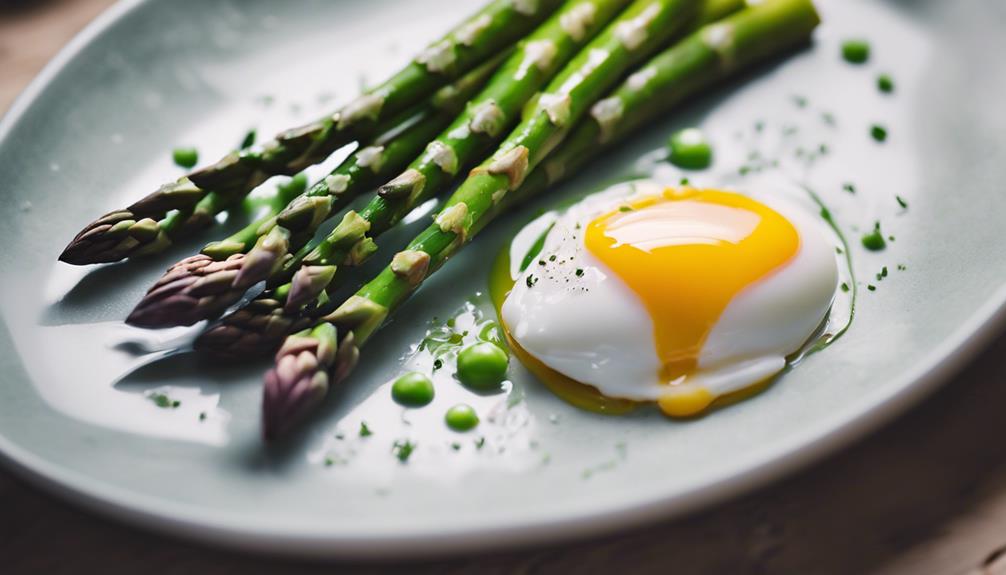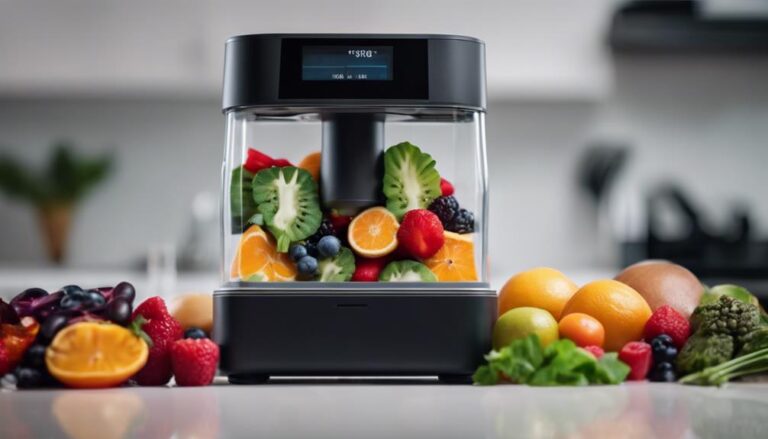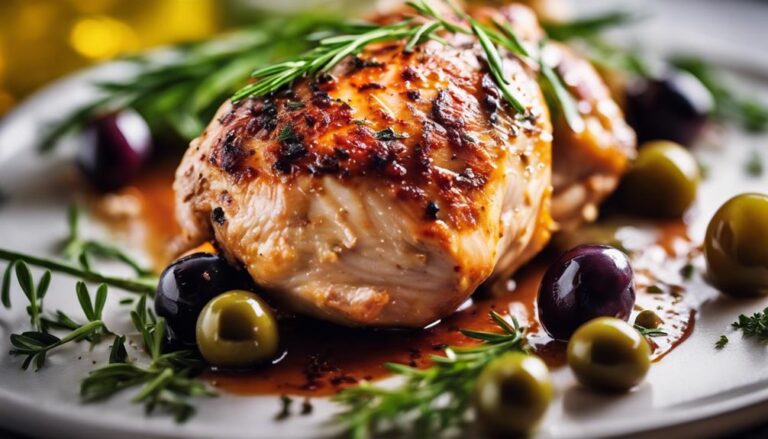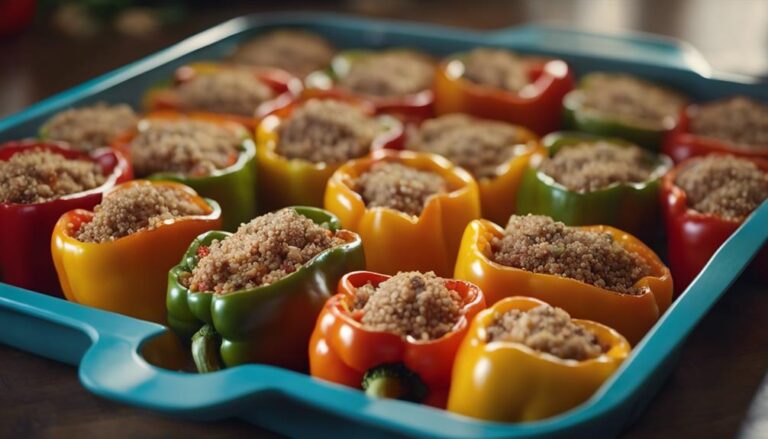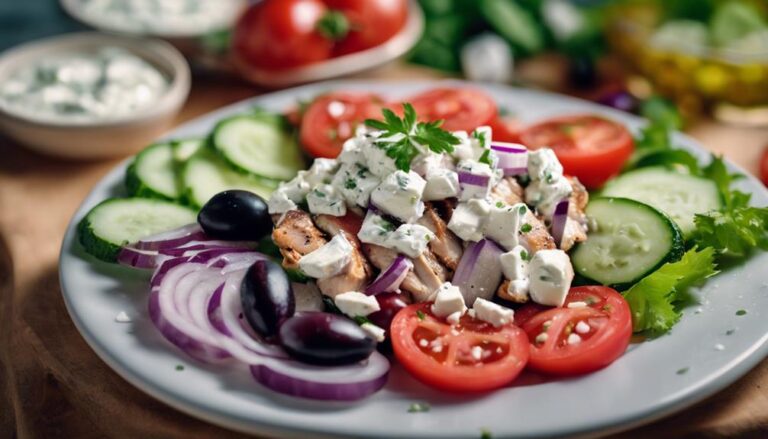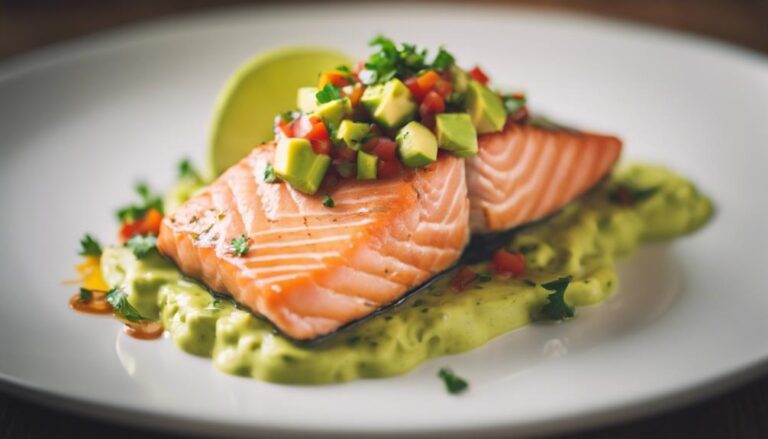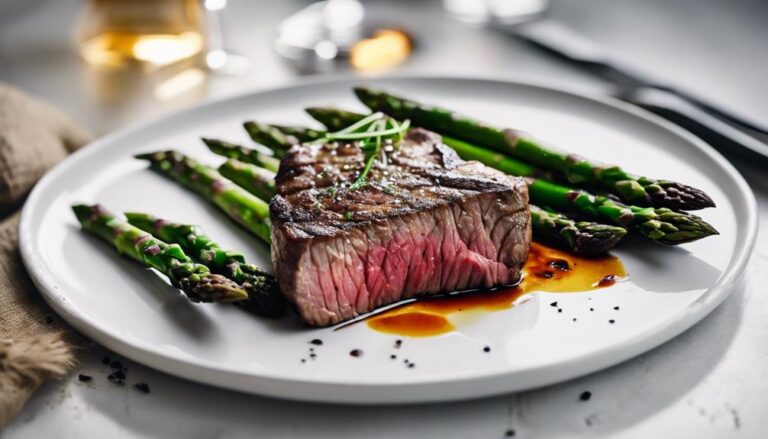Sous Vide Asparagus and Poached Egg
Indulge in the art of sous vide cooking for a divine mix of asparagus and poached egg. Begin by prepping the asparagus, trimming ends, and choosing your flavors—olive oil, herbs, or citrus zest. Set the water bath to 185°F for precise doneness. Keep an eye on cooking times to nail that perfect texture combo of tender and crunchy. The vibrant green color and crunch are locked in, while the creamy poached egg adds a touch of luxury. Immerse yourself in this culinary delight and explore a world of exquisite flavors, textures, and skills waiting to be mastered.
What You Will Learn Here
- Sous vide asparagus retains vibrant color and crispness.
- Poached egg adds velvety richness to the dish.
- Balancing tenderness and crunchiness for perfect texture.
- Experiment with cooking times and temperatures for desired results.
- Reflect on culinary experience insights for future creations.
Asparagus Cultivation Origins
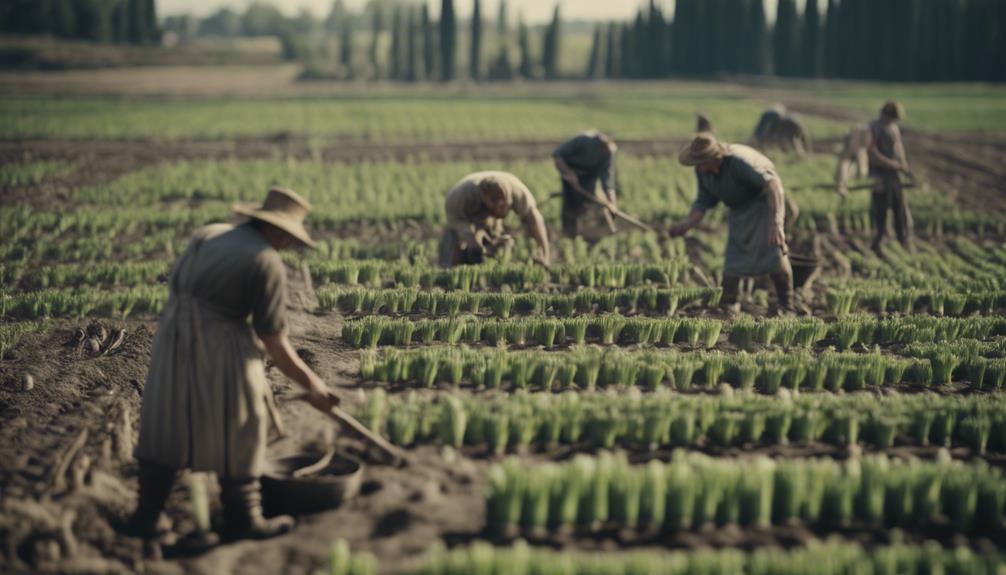
Asparagus has a rich history that dates back centuries, with early cultivation techniques being refined over time.
The cultural significance of asparagus varies across different regions, with some considering it a delicacy.
Understanding the timeline of asparagus history can provide insights into its importance in various cuisines and traditions.
Asparagus History Timeline
Having been cultivated for centuries, the origins of asparagus cultivation can be traced back to ancient Mediterranean civilizations. Asparagus, with its delicate flavor and unique appearance, has a rich history that dates back thousands of years. It's believed to have originated in the eastern Mediterranean regions and was highly prized by the ancient Greeks and Romans for its culinary and medicinal properties.
The culinary evolution of asparagus has been fascinating, with mentions of its consumption dating back to the ancient Egyptians around 3000 BC. The Greeks and Romans cultivated asparagus in large quantities, enjoying it fresh in season and preserving it by drying for consumption during the off-season. Asparagus was considered a luxury item during the Renaissance period in Europe, reserved for the tables of the wealthy and elite.
Over time, asparagus cultivation spread across Europe and eventually to other parts of the world, becoming a popular vegetable enjoyed by many cultures. Its unique taste and versatility in cooking have made it a staple in various cuisines, showcasing the enduring appeal of this ancient vegetable.
Early Cultivation Techniques
Early techniques for cultivating asparagus involved innovative methods to maximize yields and guarantee ideal growth conditions for this prized vegetable. In ancient times, early cultivators recognized the need for well-drained soil to prevent waterlogging, a common issue that could harm asparagus plants. They also utilized techniques such as planting asparagus in trenches to safeguard the delicate roots and secure proper development. These early growers understood the importance of patience, as asparagus can take a few years to establish before yielding a bountiful harvest.
While modern methods have introduced advancements like drip irrigation systems and precision planting equipment, the fundamental principles of asparagus cultivation remain rooted in these early techniques. By learning from the past and adapting to new technologies, farmers can continue to cultivate asparagus efficiently and sustainably. Understanding the historical context of early cultivation techniques provides valuable insights into the evolution of asparagus farming practices and the enduring appeal of this versatile vegetable.
Cultural Significance of Asparagus
With a rich history dating back centuries, the cultivation origins of asparagus reveal its deep-rooted cultural significance in various societies around the world. Asparagus is believed to have originated in the eastern Mediterranean region and was highly prized by ancient civilizations such as the Egyptians, Greeks, and Romans. Its cultivation spread to other parts of Europe and Asia, where it became a staple in many traditional dishes.
In addition to its delicious taste and versatility in culinary traditions, asparagus also offers numerous health benefits. It's a good source of vitamins A, C, E, and K, as well as folate and potassium. Asparagus is low in calories and rich in fiber, making it a popular choice for those looking to maintain a healthy diet.
Throughout history, the cultivation and consumption of asparagus have been intertwined with cultural practices and celebrations. In some cultures, asparagus is considered a symbol of prosperity and fertility, while in others, it's a delicacy reserved for special occasions. The enduring popularity of asparagus in various cuisines highlights its enduring cultural significance worldwide.
Asparagus Preparation Techniques
To prepare asparagus effectively, consider trimming the tough ends and peeling the stalks if necessary. Here are some tips to help you get the most out of your asparagus:
- Roasting vs. Grilling: Roasting asparagus brings out a more concentrated flavor, while grilling imparts a smoky taste. Choose the method that suits your taste preferences.
- Blanching Benefits: Blanching asparagus briefly in boiling water helps preserve its vibrant green color and crisp texture. It's a great way to prepare asparagus for salads or to freeze for later use.
- Peeling Technique: If you have thicker asparagus stalks, consider peeling them lightly to promote even cooking. This step can help the asparagus cook more evenly and improve its overall texture.
- Seasoning Suggestions: Experiment with different seasonings like olive oil, lemon zest, garlic, or Parmesan cheese to enhance the flavor of your asparagus. Don't be afraid to get creative with your seasonings to elevate your dish.
Trending Asparagus Dishes
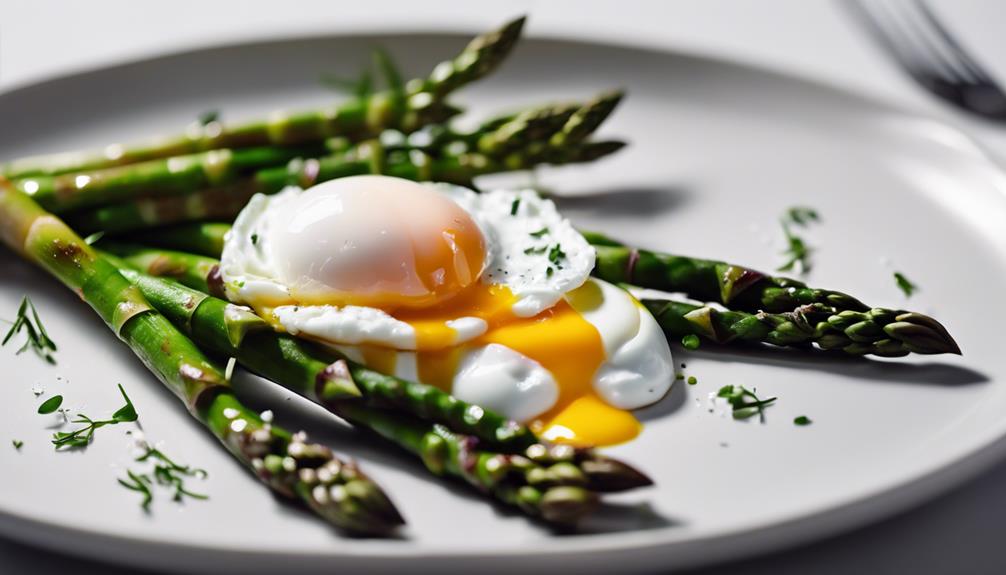
If you're looking to keep up with the latest asparagus trends, consider trying out a Sous Vide Asparagus Recipe for a modern twist on this classic vegetable.
For a more indulgent option, why not explore the Egg-Topped Asparagus Variation that combines the freshness of asparagus with the richness of a poached egg.
If you're feeling fancy, you can impress your guests with Asparagus and Prosciutto Bundles, a delightful appetizer that brings together the savory flavors of asparagus and prosciutto in a single bite.
Sous Vide Asparagus Recipe
Indulge in the latest culinary trend with this mouthwatering Sous Vide Asparagus Recipe that guarantees perfect results every time. Sous vide benefits include precise temperature control, ensuring the asparagus retains its vibrant color and nutrients. The gentle cooking method also enhances the asparagus's natural flavors, creating a tender yet crisp texture.
To achieve poached egg perfection, pair the asparagus with a delicately cooked egg that adds a creamy richness to the dish. The runny yolk beautifully complements the earthy taste of the asparagus, making each bite a harmonious blend of flavors and textures.
Follow these simple steps to create the ultimate Sous Vide Asparagus dish:
- Prepare the asparagus by trimming the ends and seasoning with olive oil, salt, and pepper.
- Vacuum-seal the seasoned asparagus in a bag to cook in the sous vide water bath.
- Set the sous vide machine to the recommended temperature and time for perfectly cooked asparagus.
- Finish by searing the asparagus in a hot pan for a caramelized exterior before serving.
Egg-Topped Asparagus Variation
For a delicious twist on traditional asparagus recipes, consider adding a perfectly poached egg atop the vibrant green spears. This Egg-Topped Asparagus Variation is a versatile dish that can be enjoyed as a breakfast pairing or a brunch favorite. Here are four reasons why you should try this delightful combination:
- Elevated Flavor: The richness of the poached egg complements the earthy taste of asparagus, creating a harmonious blend of flavors.
- Nutritional Balance: Asparagus is packed with vitamins and minerals, while eggs provide protein, making this dish a nutritious and satisfying choice.
- Visual Appeal: The bright green asparagus spears topped with a perfectly cooked egg make for an attractive and Instagram-worthy presentation.
- Versatile Dish: Whether you prefer a light breakfast or a hearty brunch, this Egg-Topped Asparagus Variation is a versatile option that can be customized to suit your taste preferences.
Asparagus and Prosciutto Bundles
Creating flavorful and elegant, Asparagus and Prosciutto Bundles have become a popular choice among trending asparagus dishes. The delicate asparagus spears are wrapped in thinly sliced prosciutto, offering a delicious blend of flavors that elevate this dish to a new level of sophistication. The creative presentation of the bundles adds a touch of elegance to any table setting.
Here are four reasons why these bundles are a must-try:
- Prosciutto pairing: The salty and savory notes of the prosciutto complement the fresh and earthy flavor of the asparagus, creating a harmonious combination that delights the taste buds.
- Easy to make: Despite their gourmet appearance, these bundles are surprisingly easy to assemble, making them a perfect choice for both novice and experienced home cooks.
- Versatile dish: Asparagus and Prosciutto Bundles can be served as an appetizer, side dish, or even as a light main course, showcasing their versatility in various meal settings.
- Impressive presentation: The visually appealing presentation of the bundles makes them a standout dish for dinner parties or special occasions, impressing guests with minimal effort.
Enhancing Asparagus Sous Vide
When enhancing your asparagus sous vide, consider experimenting with flavorful seasoning ideas to elevate the taste of the dish.
Pay close attention to the temperature and timing during the cooking process to achieve the perfect doneness.
Additionally, focus on texture perfection tips to guarantee a delightful dining experience with every bite.
Flavorful Seasoning Ideas
Consider experimenting with a variety of seasonings to elevate the taste of your sous vide asparagus. Seasoning combinations play an important role in enhancing the flavor profile of your dish. Try sprinkling your asparagus with a mix of salt, pepper, and garlic powder before sealing it in the sous vide bag. You can also infuse olive oil with herbs like thyme or rosemary and drizzle it over the asparagus for added depth of flavor.
When it comes to cooking techniques, think about incorporating citrus zest or a splash of lemon juice to brighten up the asparagus's taste. Alternatively, a sprinkle of parmesan cheese right before serving can add a savory umami kick to the dish. Don't be afraid to get creative and experiment with different herbs and spices to find your perfect flavor combination. Remember, the sous vide method locks in the asparagus's natural taste, so the seasonings you choose will shine through beautifully.
Temperature and Timing
To enhance the flavor and texture of your sous vide asparagus, focus on the precise temperature and timing during the cooking process. Timing accuracy and temperature control are essential factors in achieving the perfect sous vide asparagus. Set your water bath to a temperature of around 185°F (85°C) for a tender yet crisp result. Ensuring the water temperature remains stable is important, as fluctuations can affect the cooking process.
When it comes to timing, most asparagus will need about 10-15 minutes in the sous vide bath. However, thinner spears may require less time, so keep an eye on them. Remember, precision is key; overcooking can result in mushy asparagus, while undercooking might leave it too firm. Experimenting with different timings can help you find the ideal balance for your preferred asparagus texture.
Texture Perfection Tips
For achieving texture perfection when enhancing your asparagus sous vide, aim for a delicate balance between tenderness and crunchiness. To achieve this balance, follow these texture tips and cooking tricks.
First, consider the thickness of your asparagus spears – thinner spears will cook faster and have a more delicate crunch, while thicker ones may need a bit longer to reach the desired texture.
Next, the cooking time plays an important role in texture perfection. Be mindful not to overcook the asparagus, as it can become mushy and lose its crunch. Aim for a time that maintains a slight bite while ensuring tenderness.
Additionally, the temperature at which you sous vide your asparagus can impact its texture. Finding the right temperature sweet spot will help you achieve a perfect balance between tender and crisp.
Experimenting with different cooking times and temperatures will allow you to discover the ideal texture that suits your preference. By paying attention to these texture tips and cooking tricks, you can elevate your asparagus sous vide to a whole new level of deliciousness.
Final Thoughts

To conclude, reflect on the delightful combination of sous vide asparagus and poached egg you've just crafted. The tender asparagus, perfectly cooked using the sous vide method, complements the velvety poached egg in a harmonious blend of flavors and textures. As you savor each bite, consider the insights gained from this culinary experience. The sous vide technique not only guarantees that the asparagus retains its vibrant color and crispness but also intensifies its natural flavors. Pairing it with a delicately poached egg adds a creamy richness that elevates the dish to a new level of sophistication.
In your cooking journey, remember these cooking tips for future creations. Use fresh asparagus spears and carefully trim them to ensure uniform cooking. When poaching eggs, maintain the water at a gentle simmer and add a splash of vinegar to help the egg whites coagulate. Experiment with different seasonings and garnishes to personalize the dish to your taste preferences. Embrace the versatility of sous vide cooking and continue to explore new culinary horizons with confidence and creativity.
Frequently Asked Questions
Can I Use Frozen Asparagus for Sous Vide Cooking?
Yes, you can use frozen asparagus for sous vide cooking. Sous vide benefits from the consistent texture frozen asparagus provides. When following sous vide cooking techniques, frozen asparagus can yield excellent results with minimal effort.
What Is the Best Way to Store Asparagus for Freshness?
To keep asparagus fresh, store it upright in a glass of water in the fridge. Trim the ends, cover with a plastic bag or damp cloth, and change the water every few days. These freshness tips work wonders!
Are There Any Alternative Methods to Poaching Eggs?
When exploring alternative techniques to poaching eggs, consider methods like sous vide or boiling, which offer different textures and flavors. Experiment with scrambled eggs too for a twist on traditional poached eggs.
Can I Add Other Vegetables to the Sous Vide Asparagus Dish?
Yes, you can add a variety of vegetables to your sous vide dish. Consider creating a flavorful vegetable medley alongside the asparagus. Experiment with different flavor combinations to enhance your dish and enjoy a diverse culinary experience.
Is It Safe to Consume Asparagus That Has Turned Slightly Brown?
Yes, it's essential to prioritize food safety. When it comes to discoloration in asparagus, brown spots can indicate deterioration. While slightly browned asparagus might be safe to eat, it's best to prioritize freshness for quality consumption.
Conclusion
To sum up, sous vide asparagus and poached egg is a delicious and trendy dish that highlights the delicate flavors of asparagus while perfectly cooking the egg.
By using the sous vide method, you can achieve a perfectly tender and flavorful asparagus every time.
Whether you're a seasoned cook or just starting out, this dish is a great way to experiment with new cooking techniques and impress your friends and family with a gourmet meal.
Enjoy!
